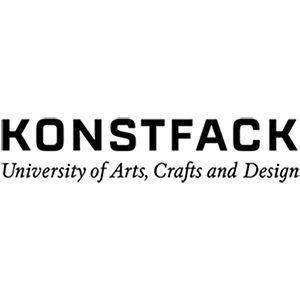Konstfack is Swedens largest university college of arts, crafts and design and has since 1844 educated artist, designers, crafters and teachers of tomorrow. All our training is based on artistic grounds and we have today around 1000 students.
History
Konstfack has had several different names since it was founded in 1844 by the ethnologist and artist Nils Månsson Mandelgren as a part-time art school for artisans, under the name “Söndags-Rit-skola för Handtverkare” (“Sunday Drawing School for Artisans”). The school was taken over by Svenska Slöjdföreningen (today known as Svensk form) the next year and renamed Svenska Slöjdföreningens skola.
In 1857, the first two female students (Sofi Granberg and Matilda Andersson) were accepted, and the following year female students officially were invited to apply.
It became a state school and was renamed Slöjdskolan i Stockholm (Handicraft School in Stockholm) in 1859; and in the context of a thorough reorganisation, where the school was divided into four departments in 1879, to Tekniska skolan (The Technical School). From 1945 it was known as Konstfackskolan (The school of art departments), when the institution was divided into the departments devoted to distinct disciplines that remain largely today: Textile, Decorative art, Sculpture, Ceramics, Furniture and Interior Design, Metal and Advertising and Printing. The school also obtained official status and had a two-year day school and a three-year arts and craft evening school. To this was added a two-year higher Arts and Crafts school and a three-year Art Teacher institute. It was given the status of a högskola (“university college”) in 1978. From 1993 it was called just Konstfack, the short form of the name formerly used colloquially.
Long located on Norrmalm, between Klara kyrka and Hötorget, the school was in 1959 moved to a new building on Valhallavägen with well-equipped workshops, designed by architects Gösta Åberg and Tage Hertzell. In 2004, it once again moved to the former headquarters of LM Ericsson at Telefonplan in Stockholm Municipality. The 20,300-square metre interior of the old factory building was redesigned by among others architect Gert Wingårdh.
Departments
Department of Crafts
The Department of Crafts offers Bachelor’s and Master ‘s programmes. The number of students amounts to around 135. The Bachelor’s programmes are given in Swedish while the Master’s programme is given in English.
Bachelor’s programmes
• Ceramics & Glass
• Textiles
• Ädellab (Jewellery and Corpus)
Department of Design, Interior Architecture and Visual Communication
The Department of Design, Interior architecture and Visual communications (DIV) offers Bachelor’s and Master ‘s programmes. The number of students amounts to almost 250. The Bachelor’s programmes are given in Swedish while the Master’s programmes are given in English.
Bachelor’s programmes
• Graphic Design & Illustration
• Industrial Design
• Interior Architecture & Furniture Design
Master’s programmes
Design – Specialisations Spatial Design and Individual Study Plan in Design
Visual Communication – graphic design and/or illustration
Department of Fine Art
The Department of Fine Art offers a three-year Bachelor programme and a two-year Master’s programme. The Bachelor’s programme comprises 180 credits/ECTS, leading to a Bachelor of Fine Arts. The Master’s programme leads to a Master of Fine Arts, and includes 120 credits/ECTS.
Department of Visual Arts and Sloyd Education
The Department of Visual Arts and Sloyd Education offers two teacher education programs.
There is also a doctoral program given in collaboration with Royal Institute of Technology.
Notable alumni
A selection of some distinguished former students at the different departments at Konstfack (Art or designer groups referred to by their collective names):
Fine Arts:
Hilma af Klint, Cecilia Edefalk, Ingela Ihrman, Stig Lindberg (textile and ceramic designer), Annika von Hausswolff, Carl Milles, Dorinel Marc, Johanna Billing, Maria Miesenberger, Miriam Bäckström, Caroline Schlyter, Karin Mamma Andersson.
Graphic Design & Illustration:
Carl Johan De Geer (artist and designer), Lasse Åberg (filmmaker), Brita Granström (artist and illustrator), Lotta Kühlhorn, Lars Hall (advertising), Oskar Korsár (artist and illustrator), Tuulikki Pietilä (artist), RBG6 (motion graphics), REALA, Stina Wirsén (illustrator), Ana Biscaia.
Interior Architecture & Furniture Design:
Claesson Koivisto Rune, Gunilla Allard, Jonas Bohlin, Mats Theselius, Stefan Borselius, Thomas Bernstrand, Greta Magnusson-Grossman.
Industrial Design:
A & E Design, Katja Pettersson, Front (arty designers), Veryday (formerly Ergonomidesign), No Picnic, Propeller, Transformator Design.
Ceramics & Glass:
Bertil Vallien, Per B. Sundberg, Zandra Ahl, Christian Pontus Andersson (artist).
Art Education:
Cecilia Torudd (cartoonist), Elsa Beskow (writer and illustrator of children’s books), Gert Z Nordström, Jan Stenmark (artist), Jockum Nordström (artist).
Textiles:
Astrid Sampe, Hans Krondahl, Mah-Jong (creators of intellectual fashion in the 1960s and 1970s); Susanne Pagold (fashion journalist), 10-gruppen.
Metal Design:
Vivianna Torun Bülow-Hübe, Gunnar Cyrén.


